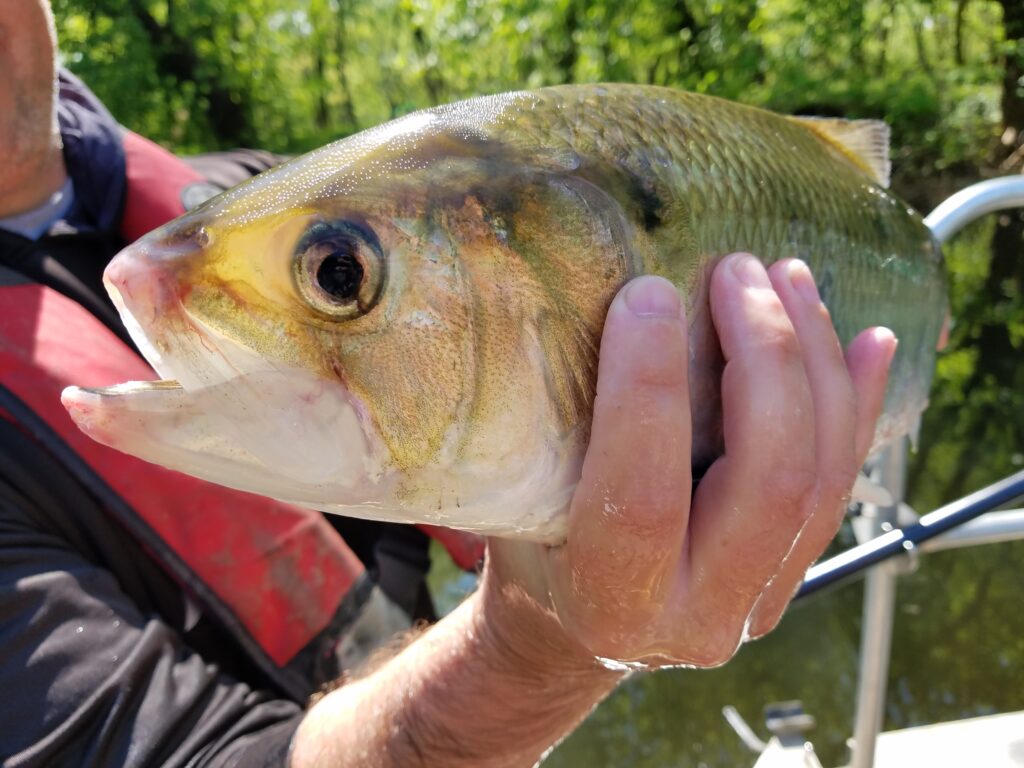Historic runs of American Shad once supported large-scale commercial fishing operations and were so plentiful they seemed limitless. Much has changed since then, and current numbers pale in comparison. American Shad face various threats as they require fresh and saltwater environments to complete their life cycle. Within freshwater, declines are primarily the result of habitat degradation and loss of aquatic connectivity. Dams severely reduce aquatic connectivity and prevent shad from reaching traditional spawning grounds, while degraded habitat makes accessible spawning areas unsatisfactory leading to poor reproduction and low recruitment. Restoration efforts focus on increasing aquatic connectivity and improving habitat. Fish ladders are one method to reconnect migratory pathways. However, their effectiveness varies. Dam removal is preferred over fish ladders (when appropriate) as it provides unrestricted passage for American Shad and other migratory and resident fish species. Increasing access to previously inaccessible spawning areas should lead to increased reproduction and, ultimately, more shad.
Consistent monitoring efforts are also needed to understand American Shad population dynamics and evaluate restoration efforts. Annual seining surveys on the Delaware River collect a variety of juvenile fishes, including American Shad. Additionally, sampling efforts following dam removal are conducted to show successful utilization of previously inaccessible river sections by anadromous fish. Environmental DNA (eDNA) is a developing technology that can detect the presence or absence of anadromous fish simply by testing collected water samples for their DNA. These survey methods are useful in tracking population trends over time and help direct and assess management actions.
Recent dam removal efforts include:
Paulins Kill – Following the successful removal of the Columbia Lake Dam in 2018, which was a total barrier to fish passage, Fish and Wildlife surveyed and found American Shad 9.5 miles upstream in Blairstown, NJ, for the first time in over 110 years. American Shad monitoring continues throughout the Paulins Kill, focusing on determining if American Shad are reproducing within the river and observing long-term trends in the population. The satisfaction of watching these fish return to stretches
of the river they’ve been absent from for over a century cannot be overstated.
Millstone River – American Shad are migrating and spawning in the Millstone River for the first time in 173 years, one year after the removal of the Weston Mill Dam in Manville (2017). Staff from NJDEP Fish and Wildlife, the U.S. Fish and Wildlife Service, and the Watershed Institute found evidence of American Shad spawning while cooperatively monitoring changes in fish assemblage following the dam removal. Five juvenile American Shad averaging 4.3 inches in length were found 4.5 miles upstream at the base of Blackwell’s Mills Dam, the next upstream barrier to shad movement.
Raritan River – Beginning in 2011, the removal of three dams opened up a nearly 10-mile stretch of the middle and upper Raritan River to American Shad for the first time in more than a century, simultaneously expanding recreational opportunities along the river. The dams removed were; the Calco Dam, Nevius Street Dam, and the Roberts Street Dam.
It is important to note that dam removal projects are completed through an active group of dedicated project partners who work collectively to restore aquatic connectivity. NJDEP’s Office of Natural Resource Restoration has also coordinated funding and supported a number of dam removal projects.
 Official Site of The State of New Jersey
Official Site of The State of New Jersey

